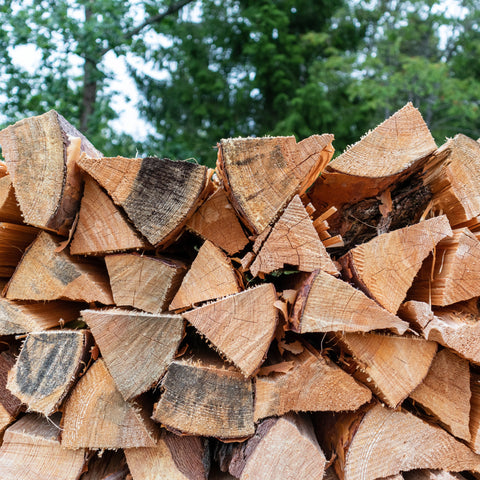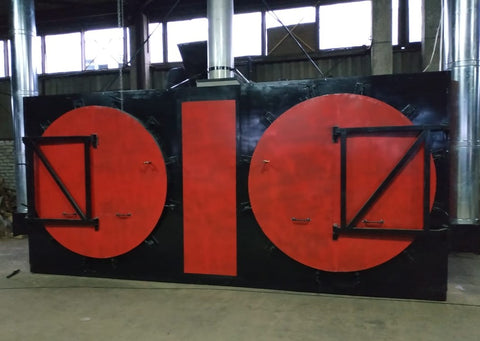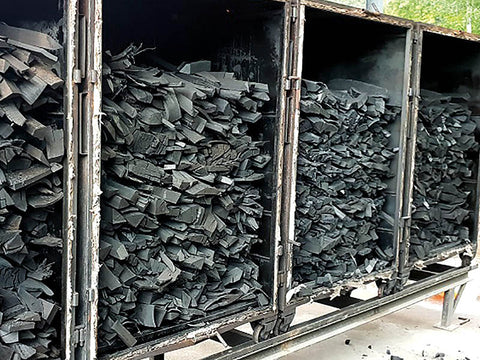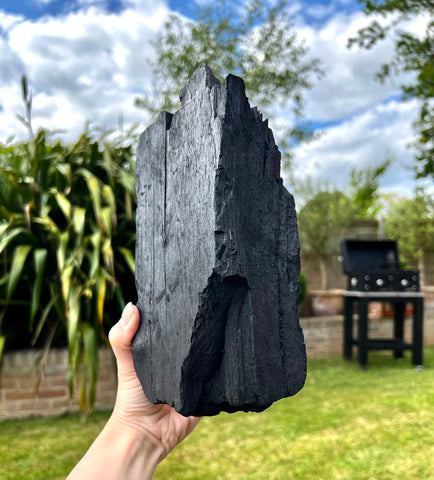Behind the Scenes at a Charcoal Factory: A Fascinating Look at the Process of Creating Charcoal
Essentially, charcoal is made by burning wood in a low-oxygen environment, which removes moisture, gases, and impurities, leaving us behind carbon-rich charcoal that burns hotter, cleaner, and longer than any others in the UK. However, the process of making it is not as simple as it may seem. In this post, we will take you behind the scenes of our production and show you the intricate steps involved in creating this black gold.

Step 1: Selecting the Right Wood
The first step in making charcoal is to select the right wood. Not all wood is created equal, and some types are better suited for making charcoal than others. For example, after testing dozens of wood, we concluded that Ukrainian birch has the best balance of heat, burning time, flavour and the lowest amount of smoke. The wood must also be seasoned, which means it has been cut and dried for several months to reduce the moisture content. Finally, it must be sustainable. Click to find out how we ensure ours is.
Step 2: Chopping the Wood
Once the wood is selected, it's time to chop it into smaller chunks. This can be done slowly with an axe, so you won't need to go to the gym for a while; or mechanically with a wood chipper to ensure even size and efficiency. The wood chunks must be uniform in size to ensure even burning and consistent quality.
Step 3: Loading the Kiln
The wood chunks are then loaded into a large metal container called a kiln. The kiln is airtight and has several vents to control the airflow and temperature. The wood chunks are arranged in layers, with each layer separated by a layer of small stones or clay balls to create a channel for the gases to escape. Once the kiln is loaded, it's sealed and the burning process begins.
Step 4: Starting the Burn
One of the kilns used to make Globaltic charcoal
The burning process is started by heating the bottom of the kiln, igniting the wood chunks. As they burn, they release volatile gases like methane, hydrogen, and carbon monoxide, which rise to the top of the kiln and are burned off by a flare stack or redirected to a combustion chamber for energy recovery. The temperature at which the wood burns in the kiln is 700-800 degrees Celsius and can take anywhere from 8 to 48 hours, depending on the size of the kiln and the type of wood being used. In our case, we maximise carbon content and make sure the wood burns fully, so it usally takes us 48 hours to burn a batch.
Step 5: Monitoring the Burn
The burning process must be closely monitored to ensure that the temperature, airflow, and burn rate are optimal. This is usually done with a combination of visual inspections, temperature sensors, and computerized controls. Average charcoal has carbon content of 50-70%. We ensure it is at least 80% with ours.

Step 6: Quenching the Charcoal
Once the burn is complete, the charcoal must be cooled and quenched to prevent it from igniting or smoldering. This is done by opening the vents and allowing air to flow through the kiln to cool the charcoal. The charcoal is then removed from the kiln and quenched with water and left to dry for several days.
Step 7: Grading and Packaging the Charcoal

Can you find a bigger lump in one our bags?
Last but not least: grading and packaging. The charcoal is graded by size and quality, with larger pieces becoming Globaltic Charcoal and ash getting turned into Globaltic Briquettes. The charcoal is then packaged in bags and shipped to the UK from our facility in Ukraine.
In conclusion, making charcoal is a complex and fascinating process that requires skill, knowledge, and attention to detail. It's a craft that has been perfected over centuries and continues to evolve with modern technology and innovation. The next time you light up your grill or smoker, take a moment to appreciate the art and science behind the charcoal that fuels your fire. We care about our products and hope you will enjoy your grilling! Check out our charcoal range for your next barbecue and thank you for reading.


Share:
From Charcoal to Community: Tracing the Origins of Barbecue Culture
The Surprising Health Benefits of Charcoal Grilling: Why You Should Fire up Your Grill Today